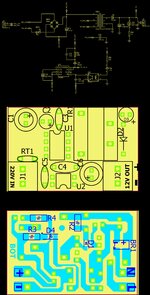gauravkothari23
Advanced Member level 2
Hi All,
i am trying to make an 12V 1 Amps SMPS using DK1203 IC.
Circuit Diagram, Top Copper and Bottom Copper with component placement file has been attached.
My problem is the SMPS works well for initial 10 to 15 minutes with the load of 850mA , but later it starts flickering. i have noticed that the IC DK1203 and the transformer gets extremely hot.
The IC is recommended for upto 12 Watts output. The Transformer winding has also been made as per the transformer datasheet.
can anybody help me out where would the problem be.
i am trying to make an 12V 1 Amps SMPS using DK1203 IC.
Circuit Diagram, Top Copper and Bottom Copper with component placement file has been attached.
My problem is the SMPS works well for initial 10 to 15 minutes with the load of 850mA , but later it starts flickering. i have noticed that the IC DK1203 and the transformer gets extremely hot.
The IC is recommended for upto 12 Watts output. The Transformer winding has also been made as per the transformer datasheet.
can anybody help me out where would the problem be.
